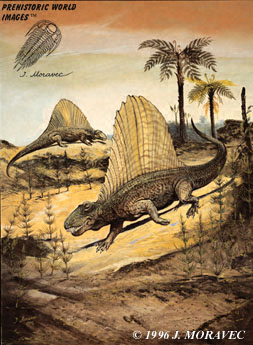
Here's something from the NY Times about the effects of the end Permian period mass extinction on the complexity of marine life.
[N]ew research suggests that [the mass extinction] was followed by an explosion of complexity in marine life, one that has persisted ever since.I know, I know. The Dimetrodon was not a marine life form. But damn, they look cool.Moreover, it happened quite suddenly, according to the study, which was led by scientists at the Field Museum of Natural History in Chicago and published in the current issue of the journal Science. The shift to complicated, interrelated ecosystems was more like a flip of a switch than a slow trend.
The researchers detected the change by analyzing records of marine fossils from 1,176 sites around the world, which are part of a new international archive, the Paleobiology Database (pbdb.org).
They found that marine life before the biggest global die-off, the Permo-Triassic extinction, was evenly split into two types of communities: simple ones, in which most species were anchored in place and got by without interacting with neighbors (like eating them or being eaten by them), and complex ones, with many interrelationships.
But since then, complex communities filled with grazers, scavengers, predators, burrowers and other mobile creatures have been three times as common as simple ones, said Peter J. Wagner, the lead author of the study.
The shift essentially took the oceans from a norm in which anchored (or sessile) creatures, including brachiopods and sea lilies, filtered food carried in currents to one dominated by roaming (or motile) fauna like snails, urchins and crabs.
Dr. Wagner said it was not clear why this particular extinction spasm had this permanent effect on the character of communities, while others did not.
A 2002 study led by Richard K. Bambach, an emeritus professor at Virginia Tech, found the general shift to a higher abundance of motile fauna from the early Triassic Period onward, but it did not examine patterns in individual communities.
But Dr. Wagner said motility was an enduring characteristic of the more variegated biological webs.
“The increased diversity of mobile species would have contributed to more complex ecological communities,” he said. “With sessile guys, everybody is just living next to one another and that’s it. With mobility and higher metabolism, you bump into each other more often, both literally and figuratively, and you end up with a greater number of potential interactions.”
The end Permian extinction was the most significant one in the history of life on Earth. The dinosaur mass extinction (end Cretaceous) was chump change in comparison.
And when are we due for another mass extinction?
Don't look now, but we're in the middle of it. And guess what else? We're the cause! Woo hoo! Go humans!

